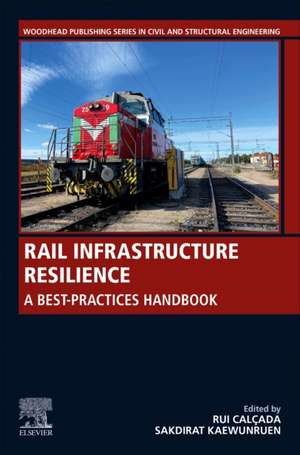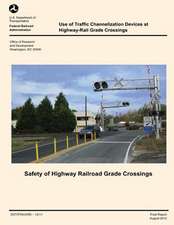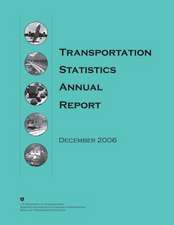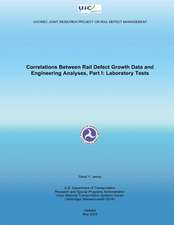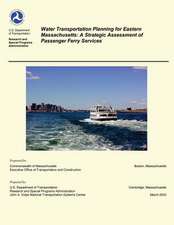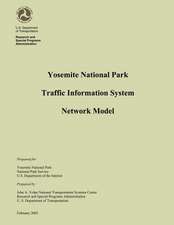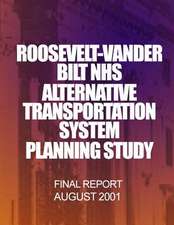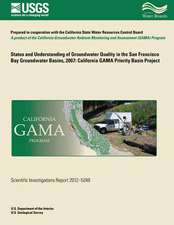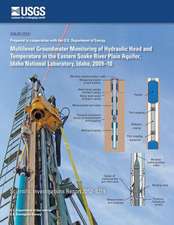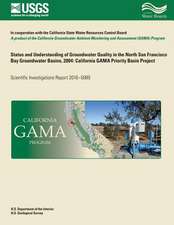Rail Infrastructure Resilience: A Best-Practices Handbook: Woodhead Publishing Series in Civil and Structural Engineering
Editat de Rui Calcada, Sakdirat Kaewunruenen Limba Engleză Paperback – 27 iun 2022
Rail Infrastructure Resilience: A Best-Practices Handbook presents developed improvement methods for rail infrastructure systems, toward resilience to extreme conditions. It shows how best to use new information in the engineering design, maintenance, construction and renewal of rail infrastructure resilience, through knowledge exchange and capability development. The book presents the outcome of a major European research project, known as the RISEN project. RISEN aimed to enhance knowledge creation and transfer using both international and intersectoral secondment mechanisms among European Advanced Rail Research Universities and SMEs, and Non-EU, leading rail universities, providing methodological approaches and practical tools for restoring and improving railway infrastructure systems for extreme events. Edited and written by members of this project, this book will be essential reading for researchers and practitioners hoping to find practical solutions to the challenges of rail infrastructure resilience.
- Offers a best-practices handbook for rail infrastructure resilience from the leaders in the field
- Paints a holistic picture of the rail transport system, showing that infrastructure maintenance intervention can be enhanced through advanced monitoring systems and resilience design
- Presents rail infrastructure resilience and advanced condition monitoring, allowing a better understanding of the critical maintenance, renewal and retrofit needs of railways
- Considers how academia, industry, communities and governments can work collaboratively in order to tackle aggregated problems in rail infrastructure resilience
- Presents the findings from the RISEN project, the leading European project on enhancing knowledge creation and transfer of expertise on rail infrastructure resilience
Din seria Woodhead Publishing Series in Civil and Structural Engineering
- 24%
 Preț: 1041.88 lei
Preț: 1041.88 lei - 9%
 Preț: 931.67 lei
Preț: 931.67 lei - 29%
 Preț: 1333.83 lei
Preț: 1333.83 lei - 29%
 Preț: 1196.79 lei
Preț: 1196.79 lei - 29%
 Preț: 1074.37 lei
Preț: 1074.37 lei - 9%
 Preț: 805.54 lei
Preț: 805.54 lei - 29%
 Preț: 1329.07 lei
Preț: 1329.07 lei - 31%
 Preț: 1008.03 lei
Preț: 1008.03 lei - 9%
 Preț: 1008.22 lei
Preț: 1008.22 lei - 27%
 Preț: 780.87 lei
Preț: 780.87 lei - 39%
 Preț: 858.21 lei
Preț: 858.21 lei - 29%
 Preț: 1333.96 lei
Preț: 1333.96 lei - 29%
 Preț: 1195.75 lei
Preț: 1195.75 lei - 9%
 Preț: 1333.91 lei
Preț: 1333.91 lei - 28%
 Preț: 1140.27 lei
Preț: 1140.27 lei - 37%
 Preț: 683.84 lei
Preț: 683.84 lei - 9%
 Preț: 879.75 lei
Preț: 879.75 lei - 23%
 Preț: 1134.17 lei
Preț: 1134.17 lei - 24%
 Preț: 922.75 lei
Preț: 922.75 lei - 39%
 Preț: 1475.52 lei
Preț: 1475.52 lei - 9%
 Preț: 900.78 lei
Preț: 900.78 lei - 39%
 Preț: 901.38 lei
Preț: 901.38 lei - 23%
 Preț: 1516.67 lei
Preț: 1516.67 lei - 9%
 Preț: 1153.90 lei
Preț: 1153.90 lei - 23%
 Preț: 1083.03 lei
Preț: 1083.03 lei - 24%
 Preț: 874.91 lei
Preț: 874.91 lei - 24%
 Preț: 1048.97 lei
Preț: 1048.97 lei - 9%
 Preț: 1107.70 lei
Preț: 1107.70 lei - 9%
 Preț: 1187.11 lei
Preț: 1187.11 lei - 23%
 Preț: 1129.22 lei
Preț: 1129.22 lei - 24%
 Preț: 986.08 lei
Preț: 986.08 lei - 28%
 Preț: 1285.96 lei
Preț: 1285.96 lei - 29%
 Preț: 1300.03 lei
Preț: 1300.03 lei - 29%
 Preț: 1280.31 lei
Preț: 1280.31 lei - 29%
 Preț: 1330.37 lei
Preț: 1330.37 lei - 9%
 Preț: 746.20 lei
Preț: 746.20 lei - 37%
 Preț: 683.94 lei
Preț: 683.94 lei - 23%
 Preț: 1202.24 lei
Preț: 1202.24 lei - 29%
 Preț: 1481.04 lei
Preț: 1481.04 lei - 9%
 Preț: 812.56 lei
Preț: 812.56 lei - 24%
 Preț: 1186.01 lei
Preț: 1186.01 lei - 9%
 Preț: 1357.19 lei
Preț: 1357.19 lei - 9%
 Preț: 842.75 lei
Preț: 842.75 lei - 23%
 Preț: 1416.53 lei
Preț: 1416.53 lei - 39%
 Preț: 1189.20 lei
Preț: 1189.20 lei - 24%
 Preț: 1162.19 lei
Preț: 1162.19 lei - 24%
 Preț: 1007.79 lei
Preț: 1007.79 lei - 9%
 Preț: 1007.35 lei
Preț: 1007.35 lei
Preț: 691.02 lei
Preț vechi: 902.44 lei
-23% Nou
Puncte Express: 1037
Preț estimativ în valută:
132.25€ • 137.02$ • 110.37£
132.25€ • 137.02$ • 110.37£
Carte tipărită la comandă
Livrare economică 15-29 martie
Preluare comenzi: 021 569.72.76
Specificații
ISBN-13: 9780128210420
ISBN-10: 0128210427
Pagini: 494
Dimensiuni: 152 x 229 x 29 mm
Greutate: 0.66 kg
Editura: ELSEVIER SCIENCE
Seria Woodhead Publishing Series in Civil and Structural Engineering
ISBN-10: 0128210427
Pagini: 494
Dimensiuni: 152 x 229 x 29 mm
Greutate: 0.66 kg
Editura: ELSEVIER SCIENCE
Seria Woodhead Publishing Series in Civil and Structural Engineering
Public țintă
Civil and railway engineers; Passenger rail and service providers; Infrastructure maintenance providers; Researchers and students of rail infrastructure and transportation systems.Stakeholders in the resilience of railways; governments and civil authorities tasked with hardening critical infrastructure against extreme events; government agencies such as environment and transport.
Cuprins
1. Introduction
2. Railway vulnerability and resilience
3. Rail resilience to climate change; embedding climate adaptation within railway operations
4. Rail Transport Resilience to Demand Shocks and COVID-19
5. Management of railway stations exposed to a terrorist threat
6. Rail infrastructure systems and hazards
7. Wheel-rail dynamic interactions
8. Wheel/Rail Management under extreme conditions
9. Train-track interactions
10. Approaches for weigh-in-motion and wheel defect detection of railway vehicles
11. Advances in ground-borne vibration management
12. Lateral resistance of continuous welded rail tracks with different types of sleepers
13. Diagnostics and management methods for sleepers
14. Maintenance strategies for rail ballast and formation
15. Inspection technologies for railway tracks
16. Risk-based Maintenance of Turnout systems
17. Railway Bridge under increased traffic demands
18. Structural health monitoring strategy for novelty detection in railway bridges using traffic induced dynamic responses
19. Improved dynamic resilience of railway bridges using external dampers
20. Monitoring and management of OHLE
21. Overhead Conductors
2. Railway vulnerability and resilience
3. Rail resilience to climate change; embedding climate adaptation within railway operations
4. Rail Transport Resilience to Demand Shocks and COVID-19
5. Management of railway stations exposed to a terrorist threat
6. Rail infrastructure systems and hazards
7. Wheel-rail dynamic interactions
8. Wheel/Rail Management under extreme conditions
9. Train-track interactions
10. Approaches for weigh-in-motion and wheel defect detection of railway vehicles
11. Advances in ground-borne vibration management
12. Lateral resistance of continuous welded rail tracks with different types of sleepers
13. Diagnostics and management methods for sleepers
14. Maintenance strategies for rail ballast and formation
15. Inspection technologies for railway tracks
16. Risk-based Maintenance of Turnout systems
17. Railway Bridge under increased traffic demands
18. Structural health monitoring strategy for novelty detection in railway bridges using traffic induced dynamic responses
19. Improved dynamic resilience of railway bridges using external dampers
20. Monitoring and management of OHLE
21. Overhead Conductors
